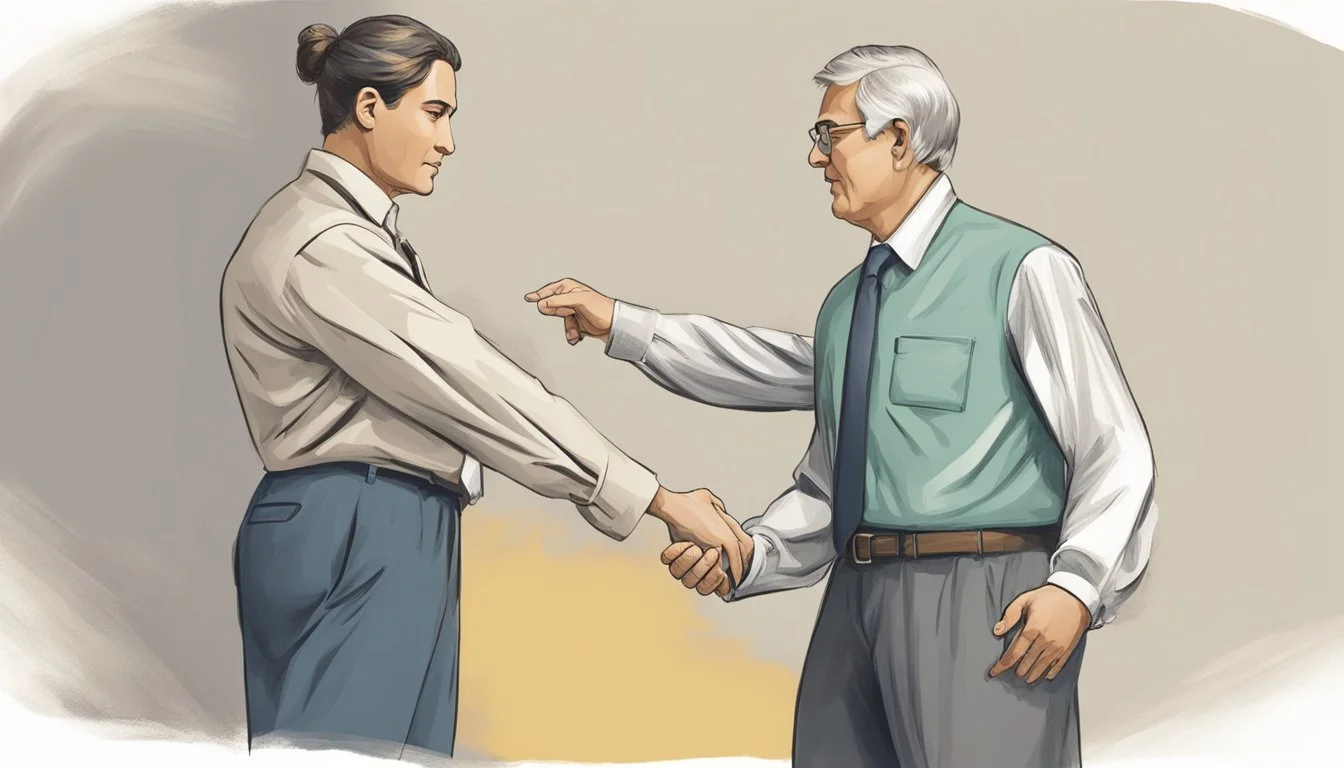8 Traits of Highly Courteous Individuals: The Key to Polite Interactions
In a world where everyday interactions shape our personal and professional lives, understanding what makes someone courteous is invaluable. Courteous individuals possess specific traits that set them apart, making them approachable and admired by people around them. These traits not only foster positive relationships but also contribute significantly to creating a harmonious and respectful environment.
What are the qualities that define highly courteous individuals? This article delves into the key traits that embody courtesy, illustrating how these characteristics manifest in everyday behavior. By examining these traits, readers can gain insight into how to cultivate a more considerate and polite demeanor in their own lives.
1) Always Says 'Please' and 'Thank You'
Highly courteous individuals understand the power of polite language. Using "please" and "thank you" can make interactions more pleasant and respectful. These phrases show appreciation and respect for others' time and efforts.
When a courteous person asks for something, they use "please" to soften the request. This small word can make a significant difference in how the request is perceived.
Similarly, they never forget to say "thank you" after receiving help or a favor. This simple act of gratitude reinforces positive behavior and makes others feel valued.
By consistently using these phrases, courteous people create a more positive and respectful environment around them. You can find more about this trait in the Habits Polite People article.
Courteous individuals also understand that these phrases are not just for friends and family but should be used with everyone they interact with. They recognize that politeness is a universal form of showing respect.
2) Makes Eye Contact
Making eye contact is an essential characteristic of courteous individuals. It shows attentiveness and respect in social interactions. When people maintain eye contact, it signals that they are engaged and interested in the conversation.
Eye contact is one of the most effective forms of nonverbal communication. It can indicate interest, attraction, and can help in building rapport with others. Properly employing patterns of gaze enhances the effectiveness of communication.
Maintaining eye contact can also help to convey emotions better. Looking someone directly in the eyes can build trust and make individuals seem more confident and genuine. People who maintain eye contact are generally viewed as honest and empathetic.
Eye contact activates the brain areas associated with empathy. This preparation helps create meaningful connections. Courteous individuals understand the impact of eye contact and use it to foster strong social interactions.
Finally, making eye contact can reduce misunderstandings. When people look at each other during conversations, it becomes easier to interpret nonverbal cues and emotions. This leads to clearer and more effective communication.
3) Listens actively
Active listening is a critical component of courtesy. It involves fully concentrating on what the speaker is saying, rather than just passively hearing their words. Courteous individuals make eye contact and provide nonverbal cues like nodding to show they are engaged.
They avoid interrupting the speaker, allowing them to express their thoughts completely. This practice shows respect for the speaker's time and perspective.
Active listeners also ask relevant questions to clarify and show genuine interest. This helps in avoiding misunderstandings and ensures they are fully grasping the speaker's message. It's not just about waiting for their turn to talk, but truly understanding the speaker.
Making an effort to validate the speaker's feelings or opinions is another aspect of active listening. They reflect back what they have heard to confirm understanding and show they are fully present in the conversation.
Active listening requires a conscious effort and practice. By doing so, courteous individuals build stronger, more respectful relationships and demonstrate true empathy and consideration. This skill also enhances their ability to resolve conflicts and communicate effectively in any setting.
Improving active listening skills can significantly enhance one's ability to be courteous and respected in personal and professional interactions.
4) Respects Personal Space
A highly courteous individual understands the importance of personal space. They recognize that everyone has different comfort levels when it comes to physical proximity.
Being able to gauge and respect these boundaries is essential. Some people require more space due to sensory sensitivities or past experiences, while others are comfortable with closer interactions.
Observing body language helps in assessing whether someone needs more or less personal space. Signs like stepping back or crossing arms can indicate a need for more distance.
In social settings, respecting personal space can foster positive connections. It shows consideration for others' feelings and helps in creating a comfortable environment.
Individuals who value personal space avoid behaviors that could be intrusive. They refrain from unnecessary touching and maintain a respectful distance during conversations.
Being mindful of personal space extends to various settings, including workplaces. Respecting colleagues' space can lead to a more harmonious and productive environment.
Maintaining boundaries is a fundamental aspect of respect. By being aware and considerate of personal space, courteous individuals contribute to the well-being and comfort of those around them.
For more information on personal space etiquette, check out this resource on maintaining boundaries and fostering positive connections.
5) Uses kind and positive language
Highly courteous individuals consistently use kind and positive language in their interactions. They understand the impact words can have, choosing phrases that uplift and encourage others. This practice not only fosters a positive atmosphere but also builds stronger relationships.
When faced with disagreements, they avoid harsh or critical words. Instead, they express their thoughts in a considerate manner. This approach helps in resolving conflicts amicably.
Acknowledging others' efforts and achievements is another hallmark of their communication. They offer praise and gratitude generously, making others feel valued and appreciated.
Courteous individuals also utilize positive reinforcements. Instead of focusing on negatives, they highlight solutions and possibilities. This optimistic outlook inspires and motivates those around them.
6) Acknowledges Others' Feelings
Highly courteous individuals excel at acknowledging others' feelings. This involves actively listening and showing genuine concern for what others are experiencing.
They don't just hear words; they pay attention to nonverbal cues such as body language and tone of voice. By doing so, they can better understand the emotions behind the words.
When someone shares their feelings, courteous people respond with empathy. This means validating those feelings, even if they do not fully agree with the perspective being shared. Their goal is to make others feel heard and valued.
They often use phrases like "I understand how you feel" or "That sounds difficult," which helps build a sense of trust and openness in conversations.
This practice is especially important in conflict situations. Acknowledging the other person's feelings can defuse tension and pave the way for more effective communication. They avoid dismissive statements and instead focus on creating a supportive environment.
For those looking to improve this trait, being mindful during interactions and practicing active listening can be beneficial. These small efforts can make a significant difference in how others perceive their sensitivity and respect.
In essence, acknowledging others' feelings is central to courtesy, fostering positive and meaningful connections.
7) Offers Help Without Being Asked
Highly courteous individuals often offer help without being asked. They are attuned to the needs of others and take proactive steps to assist, showcasing a genuine concern for others' well-being.
They are observant, quickly noticing when someone could use a hand. This attentiveness allows them to step in efficiently and provide support without waiting for a direct request.
Their willingness to help stems from empathy. They can understand and share the feelings of others, which motivates them to act kindly and thoughtfully.
Additionally, such individuals do not seek recognition for their actions. They help out of selflessness, focusing on the act of kindness itself rather than any potential praise.
It is also seen that they consistently engage in these behaviors across various situations. Whether it's at home, work, or in social settings, they remain vigilant to ways they can contribute positively.
Courteous people set a strong example for those around them, demonstrating that kindness and attentiveness can make a significant impact. Their behavior encourages a supportive community where people look out for one another.
Their actions highlight the importance of small, everyday gestures that collectively foster a culture of care and respect.
8) Waits for their turn to speak
A courteous individual always waits for their turn to speak. This practice demonstrates respect for others and their viewpoints. By allowing others to finish their thoughts, they show they value and understand different perspectives.
Waiting to speak allows conversations to flow more naturally. Interjecting or talking over someone can disrupt the discussion and create misunderstandings. A courteous person remains patient and attentive.
This behavior indicates good listening skills. When someone waits their turn, they demonstrate that they are actively listening rather than just preparing to respond. This encourages more meaningful and respectful interactions.
A courteous person doesn’t rush to dominate the conversation. They understand that dialogue is a two-way street. This approach fosters a more inclusive environment where everyone's voice is heard and respected.
Demonstrating patience in conversations is not just polite; it also fosters better relationships. People are more likely to feel valued and understood, leading to stronger connections and mutual respect.
For more insight into the habits of effective communicators, visit NPR.
Understanding Courtesy
Courtesy involves more than mere politeness; it reflects a deep respect for others and a societal norm that has evolved over time. This section offers insights into the definition and importance of courtesy and its historical context.
Definition and Importance
Courtesy is the act of showing politeness and respect toward others through behavior and actions. It is characterized by good manners, consideration, and empathy. Courteous individuals are mindful of how their actions affect others and strive to create a positive atmosphere.
Displaying courtesy can significantly enhance personal and professional relationships. It fosters a respectful and harmonious environment, reducing conflicts and misunderstandings.
Furthermore, courtesy is essential in diverse social settings. It helps in bridging cultural gaps and promoting inclusiveness. Through courteous behavior, individuals can improve their mental well-being and contribute to a more compassionate society.
Historical Context
The concept of courtesy dates back to ancient civilizations, where it was closely tied to social hierarchies and codes of conduct. In medieval times, chivalry embodied the essence of courteous behavior, especially among knights and the aristocracy.
During the Victorian era, courtesy became associated with social etiquette and formal manners. It was a marker of one's upbringing and social status. Today, while the context has evolved, the fundamental principles of courtesy remain relevant.
Modern interpretations of courtesy reflect a blend of traditional etiquette with contemporary values of equality and inclusiveness. Acts of courtesy, whether simple gestures or more significant actions, continue to play a vital role in fostering positive interactions and societal cohesion.
Psychological Foundations of Courteous Behavior
Courteous behavior is deeply rooted in psychological principles, shaped by both internal emotional understanding and external social factors. These elements combine to influence how individuals behave courteously in various settings.
Empathy and Emotional Intelligence
Empathy is the ability to understand and share the feelings of others. It allows individuals to resonate with others' emotions and respond with appropriate kindness and consideration. High levels of emotional intelligence enable individuals to recognize their own emotions and those of others, manage interpersonal relationships judiciously, and navigate social complexities.
Emotional intelligence consists of four key components: self-awareness, self-regulation, social awareness, and relationship management. Each of these components plays a crucial role in fostering courteous behavior by promoting sensitivity and responsiveness to the needs and feelings of others. Individuals with strong emotional intelligence are better equipped to show gratitude, offer help, and avoid actions that might harm others. This emphasizes the direct link between emotional awareness and courteous actions.
Social Norms and Influences
Social norms are unwritten rules about how to behave in society. They are learned through cultural teachings, family upbringing, and societal expectations. These norms act as external motivators, guiding individuals to act in socially acceptable ways. Growing up in an environment where politeness and respect are emphasized leads people to internalize these behaviors.
Social influences, such as modeling behavior from parents, peers, and role models, significantly contribute to the development of courteous traits. For example, parents teaching and modeling courteous behavior have a long-term impact on their children. Additionally, positive reinforcement from society, like praise and recognition for courteous acts, further encourages individuals to maintain and exhibit these traits consistently.
Unerstanding these psychological foundations highlights how empathy, emotional intelligence, and social norms collectively shape courteous behavior in individuals.
Real-World Applications
The traits of highly courteous individuals shine through in various aspects of daily life. In particular, these traits become evident in both everyday interpersonal exchanges and professional environments.
Everyday Interactions
In daily scenarios, courtesy manifests through actions such as greeting others warmly, listening attentively, and showing genuine concern. Simple gestures like using "please" and "thank you" foster a positive atmosphere. For instance, a courteous person might hold the door open for someone or offer their seat to an elderly individual on public transport.
Additionally, being respectful of personal space and time is crucial. For example, they avoid interrupting conversations and ensure punctuality for appointments. These actions not only make interactions smoother but also build stronger, more respectful relationships. Integrating such courteous behaviors enhances overall social harmony and goodwill.
Professional Settings
In the workplace, courteous behaviors significantly impact teamwork, client relations, and overall productivity. Courteous professionals communicate clearly, respect colleagues' opinions, and provide constructive feedback. For instance, during meetings, they listen without interrupting and acknowledge others' contributions.
Additionally, they demonstrate professionalism by honoring commitments and deadlines, which builds trust and reliability. Courteous emails and interactions with clients reflect positively on the organization, fostering long-lasting business relationships. By maintaining a polite and considerate demeanor, courteous individuals contribute to a more collaborative and efficient work environment.







